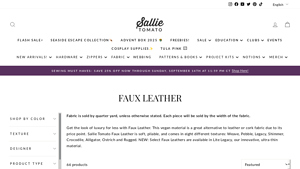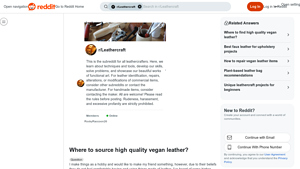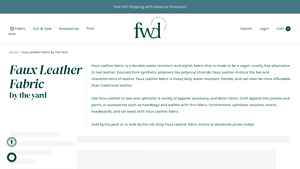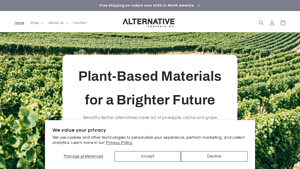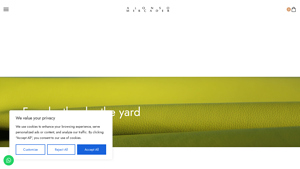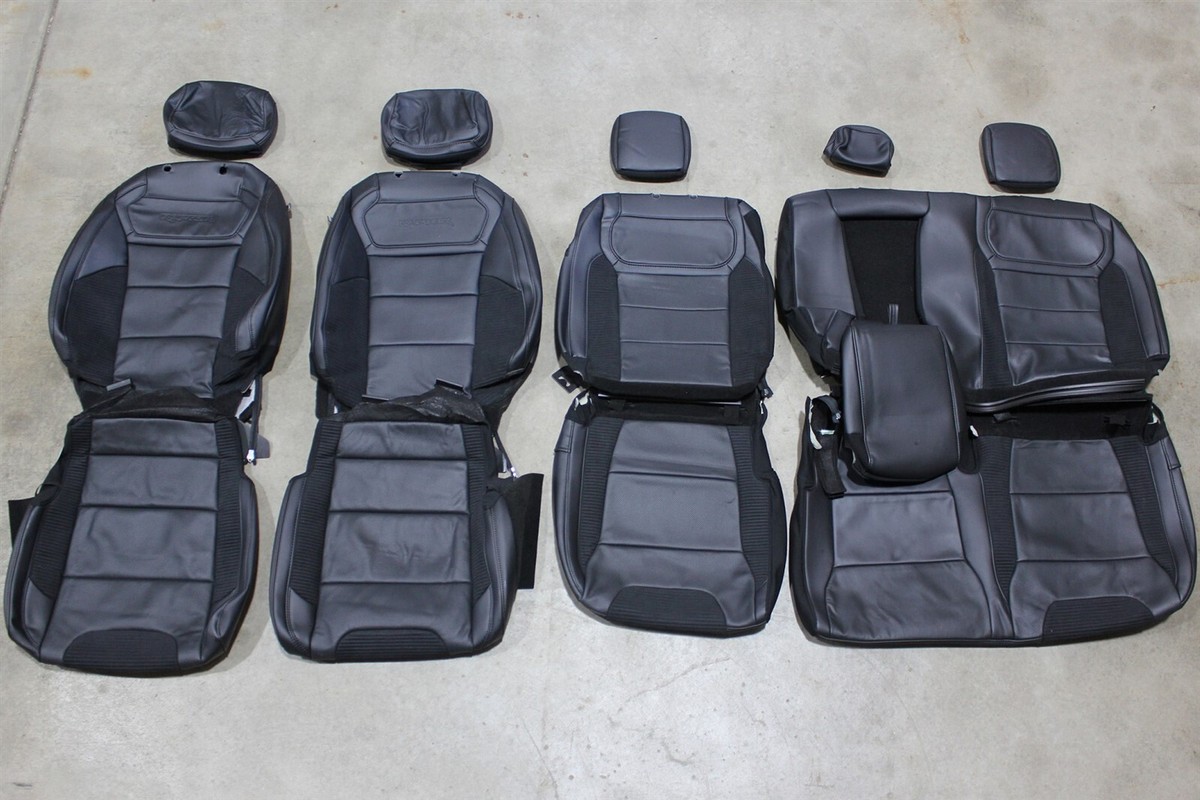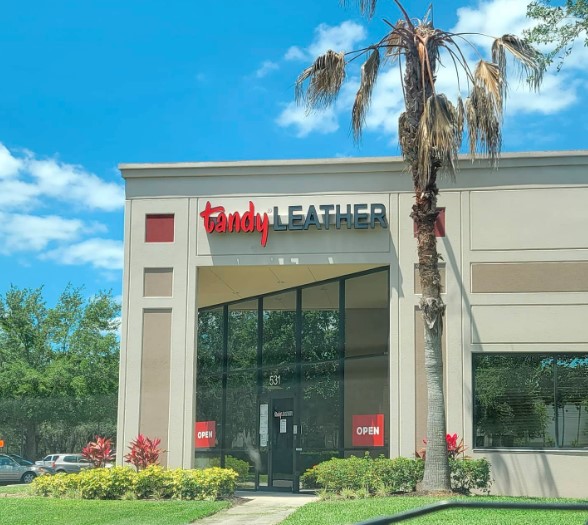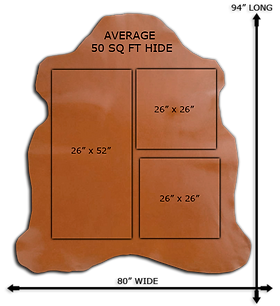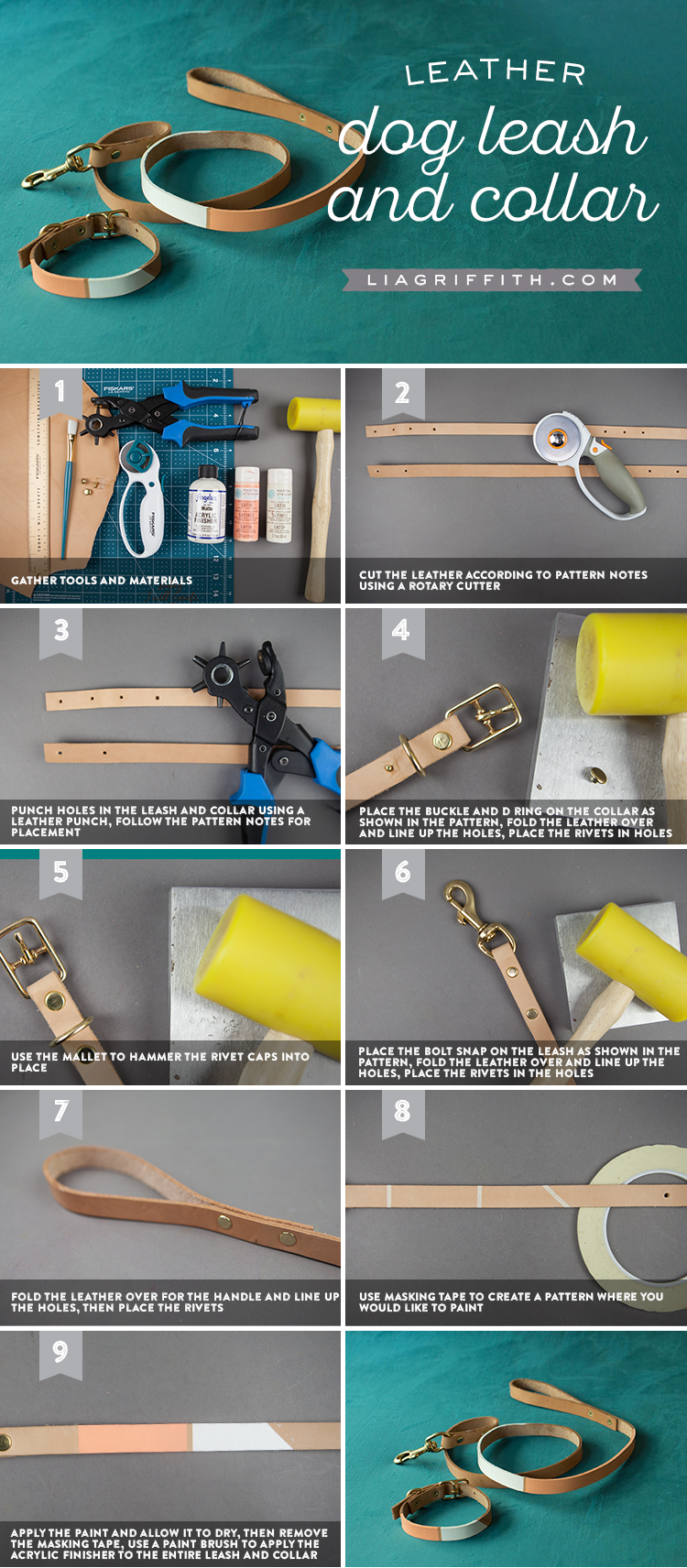Introduction: Navigating the Global Market for vegan leather fabric
In an era where sustainability is no longer just a trend but a necessity, the demand for vegan leather fabric is surging among international B2B buyers. However, navigating the complexities of sourcing high-quality, environmentally friendly alternatives to traditional leather can pose significant challenges. This guide provides a comprehensive overview of vegan leather fabric, detailing various types, applications, and the critical aspects of supplier vetting.
From understanding the diverse textures and finishes available, such as cactus leather and synthetic options, to exploring practical applications across industries—from fashion to automotive—this resource is designed to empower buyers. It emphasizes the importance of evaluating suppliers not only on price but also on sustainability practices, product quality, and reliability.
By addressing key considerations like cost, availability, and market trends, this guide equips international buyers, particularly those in Africa, South America, the Middle East, and Europe, with the insights needed to make informed purchasing decisions. Whether you’re sourcing materials for a new product line or seeking sustainable alternatives for your existing offerings, understanding the global market for vegan leather fabric is essential for maintaining competitiveness and meeting consumer demand for ethical products.
Table Of Contents
- Top 6 Vegan Leather Fabric Manufacturers & Suppliers List
- Introduction: Navigating the Global Market for vegan leather fabric
- Understanding vegan leather fabric Types and Variations
- Key Industrial Applications of vegan leather fabric
- 3 Common User Pain Points for ‘vegan leather fabric’ & Their Solutions
- Strategic Material Selection Guide for vegan leather fabric
- In-depth Look: Manufacturing Processes and Quality Assurance for vegan leather fabric
- Practical Sourcing Guide: A Step-by-Step Checklist for ‘vegan leather fabric’
- Comprehensive Cost and Pricing Analysis for vegan leather fabric Sourcing
- Alternatives Analysis: Comparing vegan leather fabric With Other Solutions
- Essential Technical Properties and Trade Terminology for vegan leather fabric
- Navigating Market Dynamics and Sourcing Trends in the vegan leather fabric Sector
- Frequently Asked Questions (FAQs) for B2B Buyers of vegan leather fabric
- Strategic Sourcing Conclusion and Outlook for vegan leather fabric
- Important Disclaimer & Terms of Use
Understanding vegan leather fabric Types and Variations
| Type Name | Key Distinguishing Features | Primary B2B Applications | Brief Pros & Cons for Buyers |
|---|---|---|---|
| Faux Leather | Synthetic materials mimicking leather, available in various textures and finishes. | Fashion, upholstery, accessories | Pros: Cost-effective, versatile; Cons: May lack breathability compared to genuine leather. |
| Cactus Leather | Plant-based alternative made from cactus fibers, offering a unique texture. | Fashion, bags, footwear | Pros: Sustainable, biodegradable; Cons: Limited availability, higher cost. |
| Hemp Leather | Durable, eco-friendly material made from hemp fibers. | Upholstery, automotive interiors, fashion | Pros: Strong, water-resistant; Cons: Can be less flexible than synthetic options. |
| Recycled Vegan Leather | Made from recycled plastics or other materials, reducing environmental impact. | Upholstery, fashion, automotive | Pros: Eco-friendly, innovative; Cons: Quality may vary based on source materials. |
| PU Leather | Polyurethane-based synthetic leather, known for its softness and flexibility. | Fashion, upholstery, accessories | Pros: Affordable, variety of colors; Cons: Less durable than other vegan options. |
What Are the Characteristics of Faux Leather for B2B Buyers?
Faux leather, often crafted from synthetic materials like PVC or polyurethane, mimics the appearance and texture of genuine leather. It is available in a wide range of textures, colors, and finishes, making it highly adaptable for various applications, from fashion items to upholstery. B2B buyers should consider its cost-effectiveness and aesthetic appeal, but should also be aware that it may not provide the same breathability or longevity as natural leather.
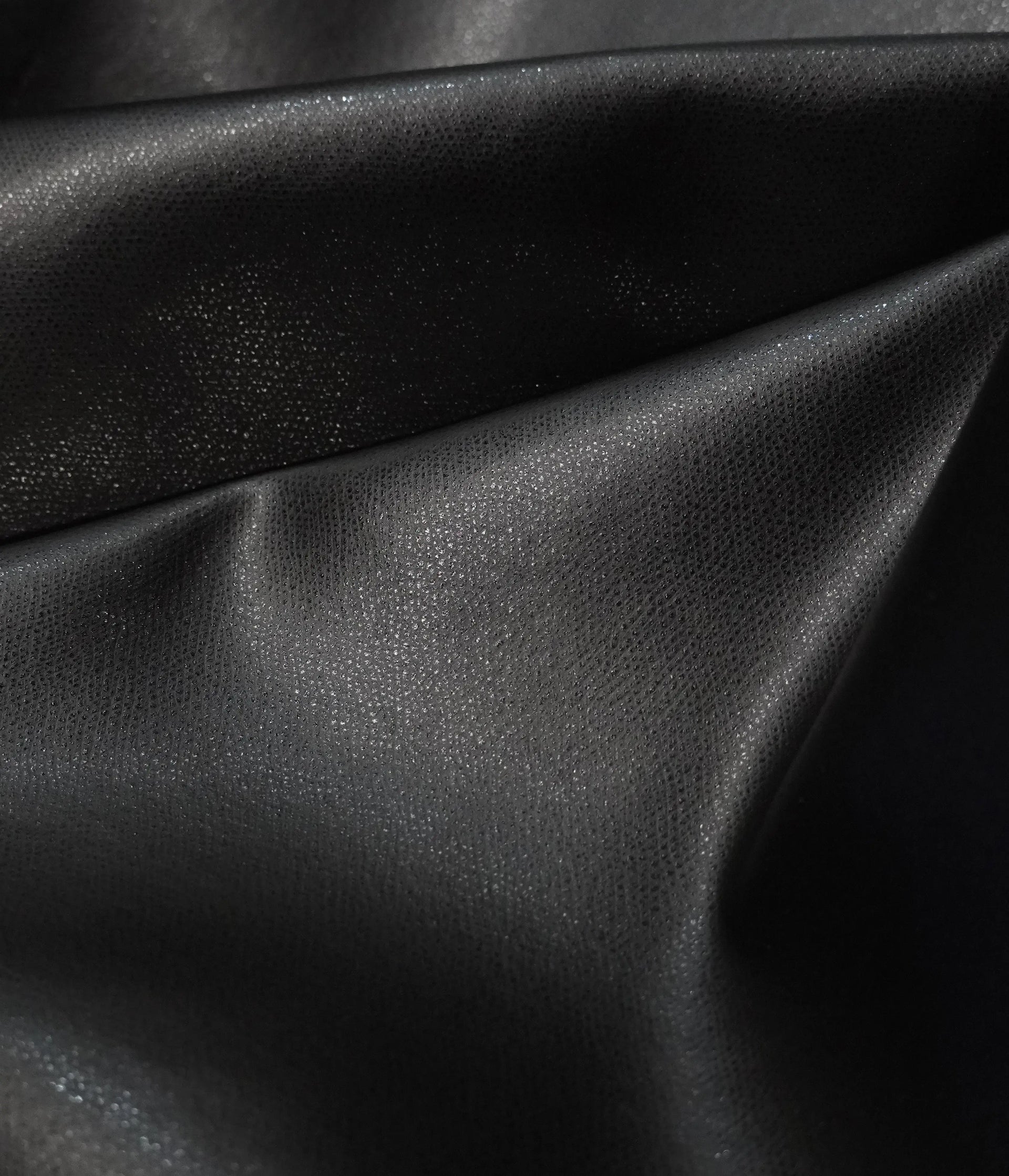
Illustrative image related to vegan leather fabric
How Does Cactus Leather Stand Out in the Vegan Leather Market?
Cactus leather is an innovative vegan leather alternative derived from cactus plants, offering a distinctive look and feel. Its sustainability stems from the minimal water required for cactus cultivation, making it an attractive option for eco-conscious brands. B2B buyers should take into account its unique texture and environmental benefits, though they may face challenges with availability and a potentially higher price point compared to synthetic alternatives.
Why Choose Hemp Leather for Durable Applications?
Hemp leather is derived from the fibers of the hemp plant, known for its remarkable strength and durability. This eco-friendly option is increasingly popular in sectors like automotive interiors and upholstery. Buyers should appreciate its water-resistant properties and sustainability credentials. However, its rigidity compared to more flexible synthetic options may limit its use in certain fashion items.
What Are the Advantages of Recycled Vegan Leather?
Recycled vegan leather is produced from repurposed plastics or other materials, contributing to a circular economy and reducing waste. This option is gaining traction in fashion and automotive industries due to its eco-friendly appeal. While it offers innovative solutions for sustainability, buyers should be cautious about the variability in quality based on the source materials used in production.
How Does PU Leather Compare to Other Vegan Leather Types?
PU leather, made from polyurethane, is a widely used synthetic alternative that is appreciated for its softness and flexibility. It is available in numerous colors and finishes, making it suitable for fashion and upholstery applications. B2B buyers benefit from its affordability and ease of maintenance but should be aware that it may not hold up as well over time compared to more durable vegan options like cactus or hemp leather.
Key Industrial Applications of vegan leather fabric
| Industry/Sector | Specific Application of vegan leather fabric | Value/Benefit for the Business | Key Sourcing Considerations for this Application |
|---|---|---|---|
| Fashion and Apparel | Clothing and Accessories | Cost-effective alternative to animal leather | Quality, texture variety, compliance with ethical standards |
| Automotive | Upholstery and Interior Design | Sustainable option that appeals to eco-conscious consumers | Durability, resistance to wear and tear, color options |
| Furniture and Home Decor | Upholstery for Sofas and Chairs | Enhances aesthetics while being environmentally friendly | Colorfastness, stain resistance, and maintenance requirements |
| Footwear | Shoes and Boots | Lightweight and versatile, providing style without sacrificing ethics | Breathability, flexibility, and texture options |
| Sporting Goods | Equipment and Gear | Lightweight and weather-resistant, suitable for various sports | Performance characteristics, durability, and environmental impact |
How is Vegan Leather Fabric Used in the Fashion and Apparel Industry?
In the fashion and apparel sector, vegan leather fabric is predominantly used for creating clothing and accessories, such as jackets, handbags, and belts. This material offers a cost-effective alternative to traditional leather while also appealing to the growing consumer demand for ethical and sustainable fashion. For international buyers, especially from Africa and South America, sourcing vegan leather requires attention to quality and texture variety, ensuring that the products meet local market preferences and ethical standards.
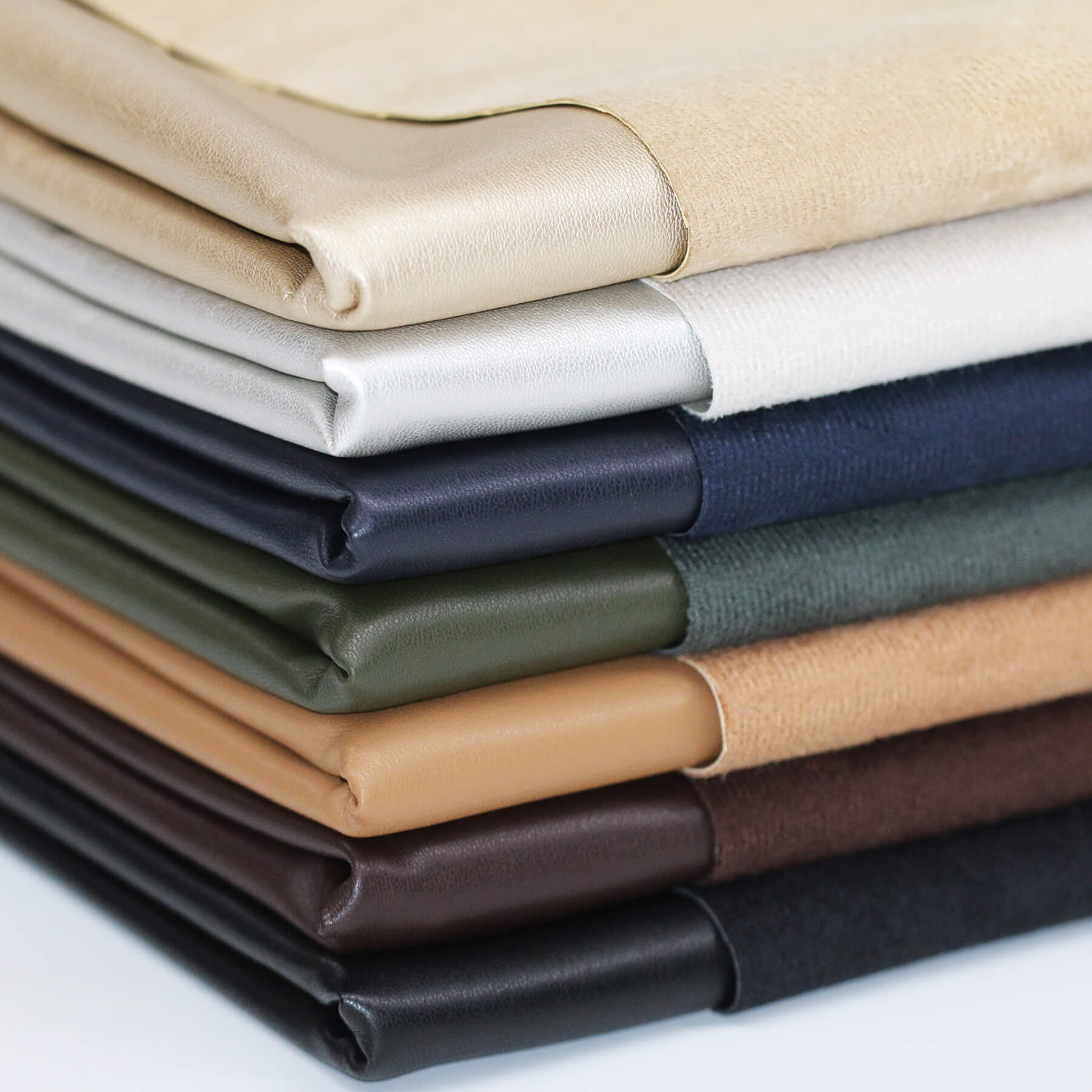
Illustrative image related to vegan leather fabric
What Role Does Vegan Leather Play in the Automotive Industry?
Vegan leather is increasingly utilized in automotive upholstery and interior design, providing a sustainable option that resonates with environmentally conscious consumers. This fabric not only enhances the visual appeal of vehicle interiors but also offers durability and ease of maintenance. Buyers from regions like Europe and the Middle East should prioritize sourcing options that emphasize wear resistance and color variety to align with market trends and consumer preferences.
How is Vegan Leather Fabric Applied in Furniture and Home Decor?
In furniture and home decor, vegan leather is commonly used for upholstery on sofas, chairs, and cushions. It allows manufacturers to create stylish, modern designs while maintaining a commitment to sustainability. Buyers need to consider factors such as colorfastness and stain resistance to ensure long-lasting products that meet consumer expectations for quality and aesthetics. This is particularly relevant for international buyers who cater to diverse market tastes.
What Advantages Does Vegan Leather Provide in Footwear Manufacturing?
The footwear industry benefits from vegan leather as it provides a lightweight and versatile option for shoes and boots. This material can mimic the look and feel of traditional leather while offering ethical alternatives. For B2B buyers, especially in regions like Vietnam and Brazil, sourcing vegan leather that emphasizes breathability and flexibility is essential, as these characteristics significantly impact consumer comfort and satisfaction.
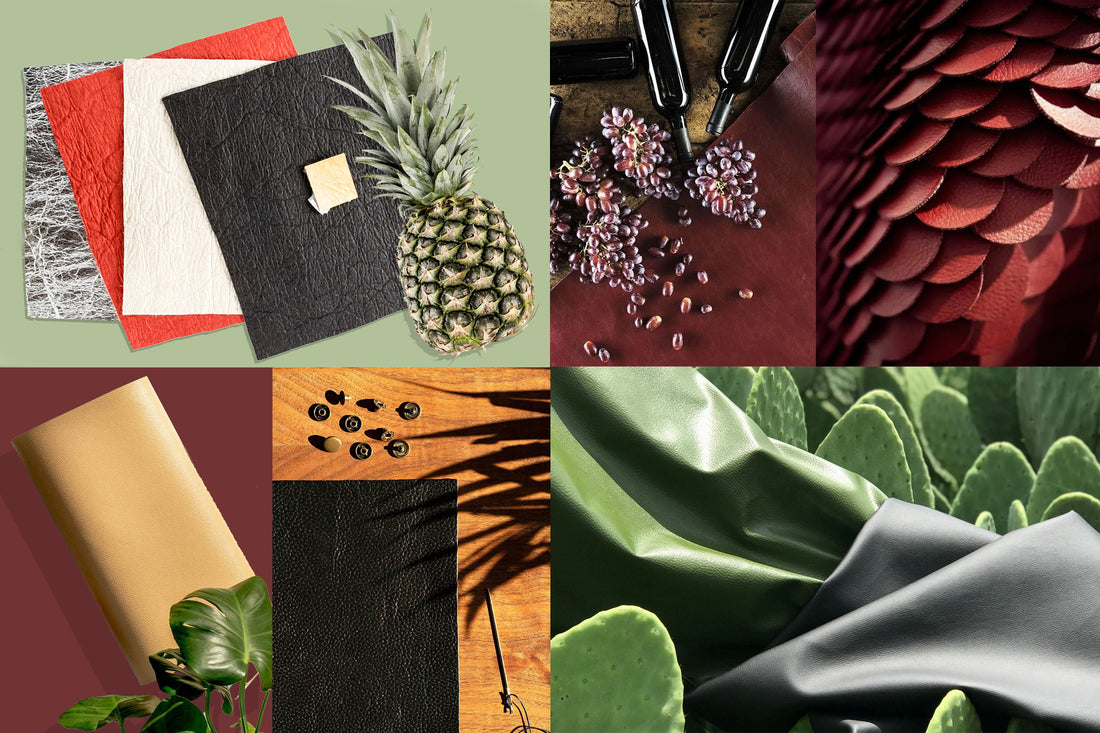
Illustrative image related to vegan leather fabric
How is Vegan Leather Utilized in Sporting Goods?
In the sporting goods sector, vegan leather is often used for equipment and gear, providing lightweight, weather-resistant options suitable for various sports. This material can enhance performance while aligning with the growing consumer trend towards sustainability. Buyers should focus on the performance characteristics and durability of vegan leather products, ensuring they meet the rigorous demands of sports enthusiasts while maintaining a minimal environmental footprint.
3 Common User Pain Points for ‘vegan leather fabric’ & Their Solutions
Scenario 1: Sourcing Quality Vegan Leather Fabric Consistently
The Problem: B2B buyers often struggle to find reliable suppliers that offer high-quality vegan leather fabric. Variability in quality can lead to production delays, increased costs, and ultimately dissatisfied customers. Buyers may receive materials that do not meet their specifications, leading to wasted resources and potential reputational damage. For instance, a furniture manufacturer may source vegan leather that looks appealing but fails to withstand regular wear and tear, resulting in returns and loss of trust from clients.
The Solution: To mitigate sourcing issues, B2B buyers should establish partnerships with reputable suppliers who have a proven track record. It’s essential to conduct thorough research, including visiting production facilities if possible and requesting samples to assess quality firsthand. Buyers should also inquire about the materials used in the vegan leather, including the manufacturing process and certifications. Creating a standardized specification sheet that includes desired characteristics such as durability, texture, and color consistency can further streamline the sourcing process. Engaging in regular communication with suppliers can help ensure that any changes in production are communicated in advance, allowing buyers to make informed decisions.
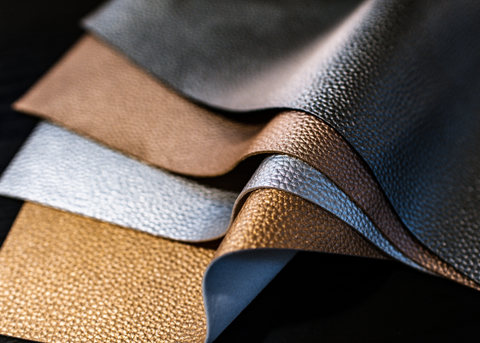
Illustrative image related to vegan leather fabric
Scenario 2: Navigating the Diverse Applications of Vegan Leather Fabric
The Problem: With the variety of vegan leather fabrics available, B2B buyers may find it challenging to determine the best material for specific applications. For example, a fashion brand may require a lightweight, flexible vegan leather for clothing, while an automotive company may need a more robust, weather-resistant option for upholstery. Misjudging the suitability of a fabric can lead to product failures, increased costs, and damage to brand reputation.
The Solution: To address this pain point, buyers should invest time in understanding the properties of different vegan leather types and their ideal applications. Creating a detailed matrix that outlines the strengths and weaknesses of each fabric type can serve as a quick reference guide. Collaborating with fabric experts or consultants can provide insights into material properties that align with specific needs. Additionally, conducting small-scale pilot tests with the selected fabrics can help evaluate their performance in real-world applications before committing to larger orders. This proactive approach can lead to more informed decisions, ensuring that the right vegan leather is used for each purpose.
Scenario 3: Understanding Environmental Impact and Consumer Expectations
The Problem: As sustainability becomes a crucial factor in purchasing decisions, B2B buyers face the challenge of ensuring that their vegan leather fabric aligns with eco-friendly practices. Buyers may encounter fabrics that are marketed as “vegan” but are made from non-sustainable materials or involve harmful production processes. This disconnect can result in backlash from environmentally conscious consumers, affecting sales and brand loyalty.
The Solution: To navigate this landscape, buyers should prioritize sourcing vegan leather that is certified by reputable environmental organizations. Researching the life cycle of materials used in the production of vegan leather, including sourcing, manufacturing, and end-of-life disposal, is essential. Buyers can ask suppliers for transparency regarding their sustainability practices, including waste management and chemical usage. Furthermore, communicating the environmental benefits of the chosen materials to end consumers can enhance brand positioning and customer loyalty. By making informed choices and promoting sustainable practices, B2B buyers can meet consumer expectations while contributing to a more sustainable industry.
Strategic Material Selection Guide for vegan leather fabric
What Are the Key Properties of Common Vegan Leather Materials?
Vegan leather, also known as faux leather, is increasingly popular in various industries, offering a sustainable alternative to traditional leather. Here, we analyze four common materials used in the production of vegan leather: polyurethane (PU), polyvinyl chloride (PVC), pineapple leather (Piñatex), and cactus leather. Each material has unique properties, advantages, and limitations that influence their suitability for specific applications.
How Does Polyurethane (PU) Compare as a Vegan Leather Option?
Polyurethane is a widely used synthetic material for vegan leather. It offers excellent flexibility and a soft texture, making it suitable for products like bags, shoes, and upholstery. PU is resistant to abrasion and can withstand moderate temperatures, which enhances its durability in various applications.
Pros and Cons: The primary advantage of PU is its aesthetic appeal, closely resembling genuine leather. However, it can be less breathable than natural materials, which may affect comfort in certain applications. Additionally, while PU is generally more affordable than real leather, its manufacturing process can be complex, potentially increasing costs.
Impact on Application: PU is compatible with a range of media, including dyes and prints, making it ideal for fashion and upholstery. However, buyers should consider its environmental impact, as not all PU is produced sustainably.
What Advantages Does Polyvinyl Chloride (PVC) Offer in Vegan Leather Production?
PVC is another synthetic material used in vegan leather production. It is known for its durability and water resistance, making it suitable for outdoor applications, such as automotive upholstery and outdoor furniture.
Pros and Cons: The key advantage of PVC is its cost-effectiveness and wide availability. However, it is less flexible than PU and can become stiff over time. Furthermore, the production of PVC can release harmful chemicals, raising environmental concerns that buyers should address.
Impact on Application: PVC’s water-resistant properties make it ideal for applications requiring moisture protection. However, its rigidity may limit its use in fashion items that require a softer touch.
How Do Natural Alternatives Like Pineapple Leather (Piñatex) Perform?
Piñatex is an innovative vegan leather alternative made from pineapple leaf fibers. It is biodegradable and offers a unique texture that appeals to eco-conscious consumers.
Pros and Cons: The primary advantage of Piñatex is its sustainability and the use of agricultural waste, which reduces environmental impact. However, it may not be as durable as synthetic options, and its production costs can be higher due to the labor-intensive process.
Impact on Application: Piñatex is suitable for fashion accessories and home décor, but its limited durability may restrict its use in high-wear applications.
What Are the Benefits of Cactus Leather in Vegan Leather Fabric?
Cactus leather, derived from the nopal cactus, is gaining traction as a sustainable vegan leather option. It is known for its durability and natural texture.
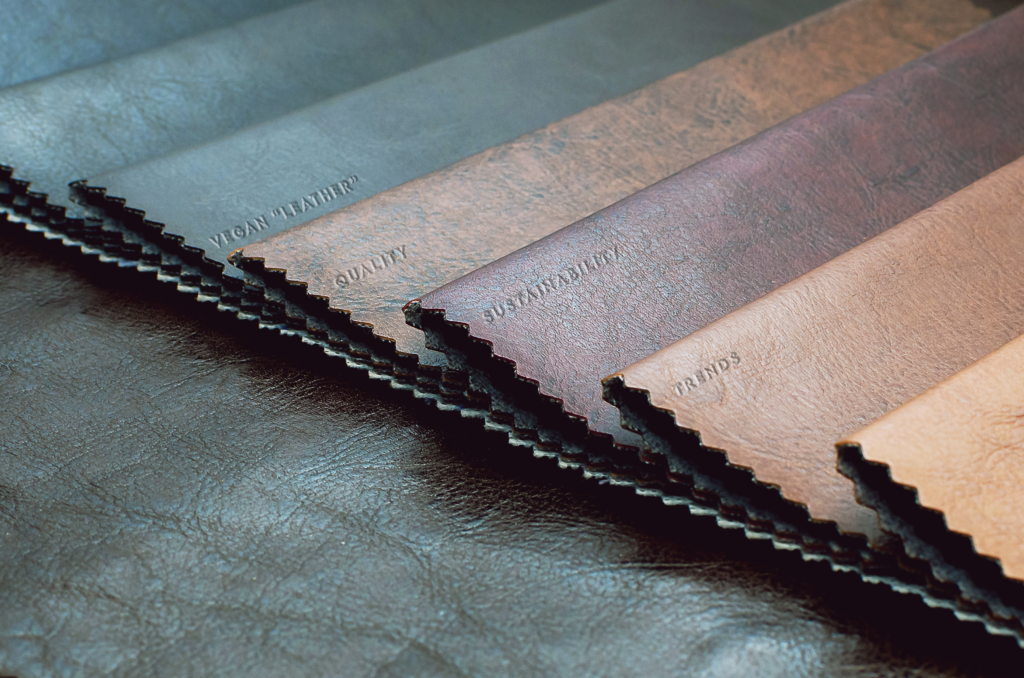
Illustrative image related to vegan leather fabric
Pros and Cons: The main advantage of cactus leather is its eco-friendly production process, which requires minimal water and resources. However, it can be more expensive than synthetic alternatives, and its availability may be limited in certain regions.
Impact on Application: Cactus leather is suitable for high-end fashion and accessories, but buyers should ensure that they can source it consistently to meet demand.
Summary of Material Selection for Vegan Leather
| Material | Typical Use Case for vegan leather fabric | Key Advantage | Key Disadvantage/Limitation | Relative Cost (Low/Med/High) |
|---|---|---|---|---|
| Polyurethane (PU) | Bags, shoes, upholstery | Soft texture, aesthetic appeal | Less breathable, complex manufacturing | Medium |
| Polyvinyl Chloride (PVC) | Automotive upholstery, outdoor furniture | Cost-effective, durable | Can become stiff, environmental concerns | Low |
| Pineapple Leather (Piñatex) | Fashion accessories, home décor | Sustainable, biodegradable | Limited durability, higher production costs | High |
| Cactus Leather | High-end fashion, accessories | Eco-friendly, minimal resource use | Higher cost, limited availability | High |
This guide provides B2B buyers with crucial insights into the materials available for vegan leather, allowing them to make informed decisions based on performance, cost, and sustainability. Understanding these factors is essential for sourcing products that align with market demands and environmental standards.
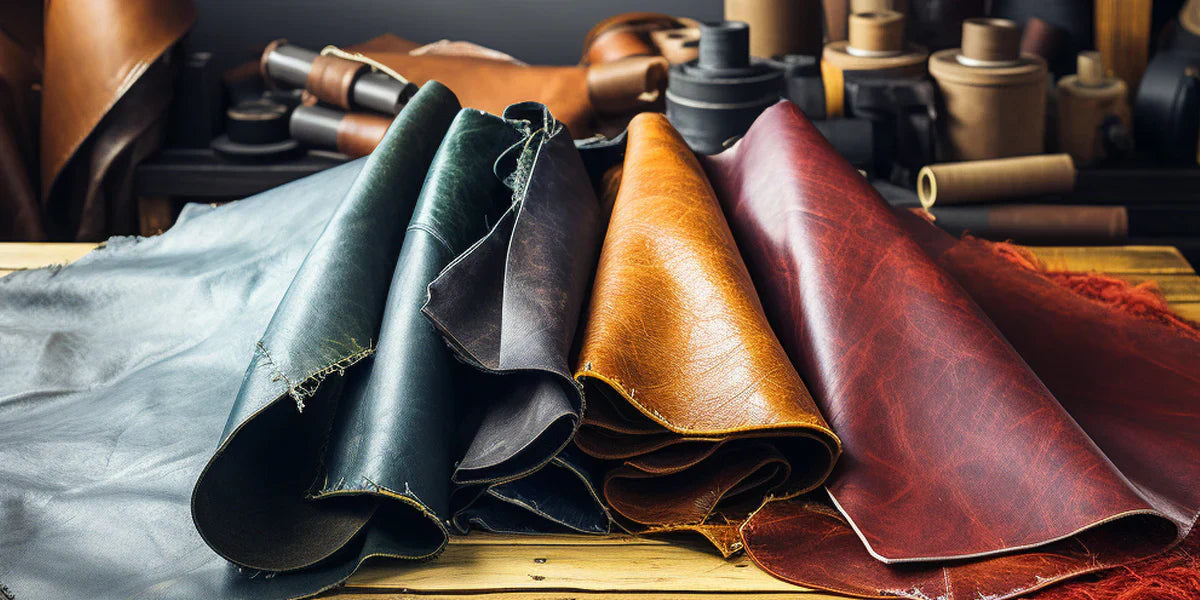
Illustrative image related to vegan leather fabric
In-depth Look: Manufacturing Processes and Quality Assurance for vegan leather fabric
What Are the Main Stages in the Manufacturing Process of Vegan Leather Fabric?
The manufacturing process of vegan leather fabric typically involves several key stages: material preparation, forming, assembly, and finishing. Each stage is crucial for ensuring the final product meets the desired quality standards and specifications.
-
Material Preparation: The first step is sourcing sustainable materials, which can include polyurethane (PU), polyvinyl chloride (PVC), or innovative plant-based materials like cactus, pineapple, or apple leather. These materials are selected based on their durability, texture, and environmental impact. The preparation process also involves treating these materials to enhance their properties, such as flexibility and resistance to wear.
-
Forming: In this stage, the prepared materials are shaped into sheets or rolls. Advanced techniques such as calendaring (pressing materials through rollers) or coating are often employed to achieve the desired thickness and texture. For instance, vegan leather can be embossed with patterns to mimic traditional leather. This process requires precision to ensure uniformity in texture and appearance.
-
Assembly: Once formed, the sheets of vegan leather are cut and sewn into various products such as bags, upholstery, or garments. This stage may involve additional treatments, such as adhesive application, to enhance the product’s durability and aesthetic appeal. Automation and skilled craftsmanship play essential roles in this phase to maintain quality and efficiency.
-
Finishing: The final stage involves applying coatings or treatments to enhance the aesthetic qualities of the vegan leather. This can include UV protection, water resistance, or color treatments. Quality control checks are conducted during this stage to ensure that the product meets the specified requirements before packaging.
What Key Techniques Are Used in Vegan Leather Fabric Production?
The production of vegan leather fabric employs various techniques to achieve high-quality results. Some of the most notable techniques include:
-
Digital Printing: This technique allows for intricate designs and patterns to be printed directly onto the vegan leather, providing customization options for B2B buyers. It is particularly beneficial for brands looking to differentiate their products in a competitive market.
-
Lamination: This process involves bonding layers of materials together, which can enhance the durability and water-resistance of the vegan leather. It also allows for the incorporation of different textures and finishes.
-
Embossing and Debossing: These techniques create tactile surfaces that mimic the look and feel of traditional leather. Embossing raises the surface pattern, while debossing creates a recessed design, both adding value to the final product.
How Is Quality Assurance Implemented in Vegan Leather Fabric Manufacturing?
Quality assurance in the manufacturing of vegan leather fabric is vital for ensuring product consistency and reliability. International standards such as ISO 9001 provide a framework for quality management systems, while industry-specific standards like CE and API ensure compliance with safety and performance requirements.
- Quality Control Checkpoints: Several checkpoints are established throughout the manufacturing process to monitor quality. These include:
- Incoming Quality Control (IQC): This involves inspecting raw materials upon arrival to ensure they meet specified quality standards.
- In-Process Quality Control (IPQC): Continuous monitoring during the production process helps identify and rectify issues in real time, minimizing waste and defects.
- Final Quality Control (FQC): A comprehensive inspection of the finished products is conducted before they are shipped to ensure they meet all quality specifications.
- Common Testing Methods: Various testing methods are utilized to assess the quality of vegan leather fabrics, including:
- Physical Testing: Assessing properties such as tensile strength, tear resistance, and abrasion resistance.
- Chemical Testing: Ensuring that the materials are free from harmful substances and comply with regulations.
- Durability Testing: Evaluating how the fabric performs under different conditions, such as exposure to UV light or water.
How Can B2B Buyers Verify Supplier Quality Control?
For international B2B buyers, particularly those from regions like Africa, South America, the Middle East, and Europe, verifying a supplier’s quality control processes is crucial. Here are effective strategies for doing so:
-
Supplier Audits: Conducting on-site audits allows buyers to evaluate the supplier’s manufacturing processes and quality control systems firsthand. This can provide insights into their capabilities and adherence to international standards.
-
Quality Assurance Reports: Requesting detailed quality assurance documentation, including inspection reports and certificates, can help buyers assess the supplier’s commitment to quality.
-
Third-Party Inspections: Engaging third-party inspection agencies can provide an unbiased evaluation of the supplier’s products and processes. This step adds an extra layer of assurance regarding quality.
What Nuances Should International B2B Buyers Consider Regarding QC?
When sourcing vegan leather fabric internationally, B2B buyers should be aware of specific nuances that may affect quality control:
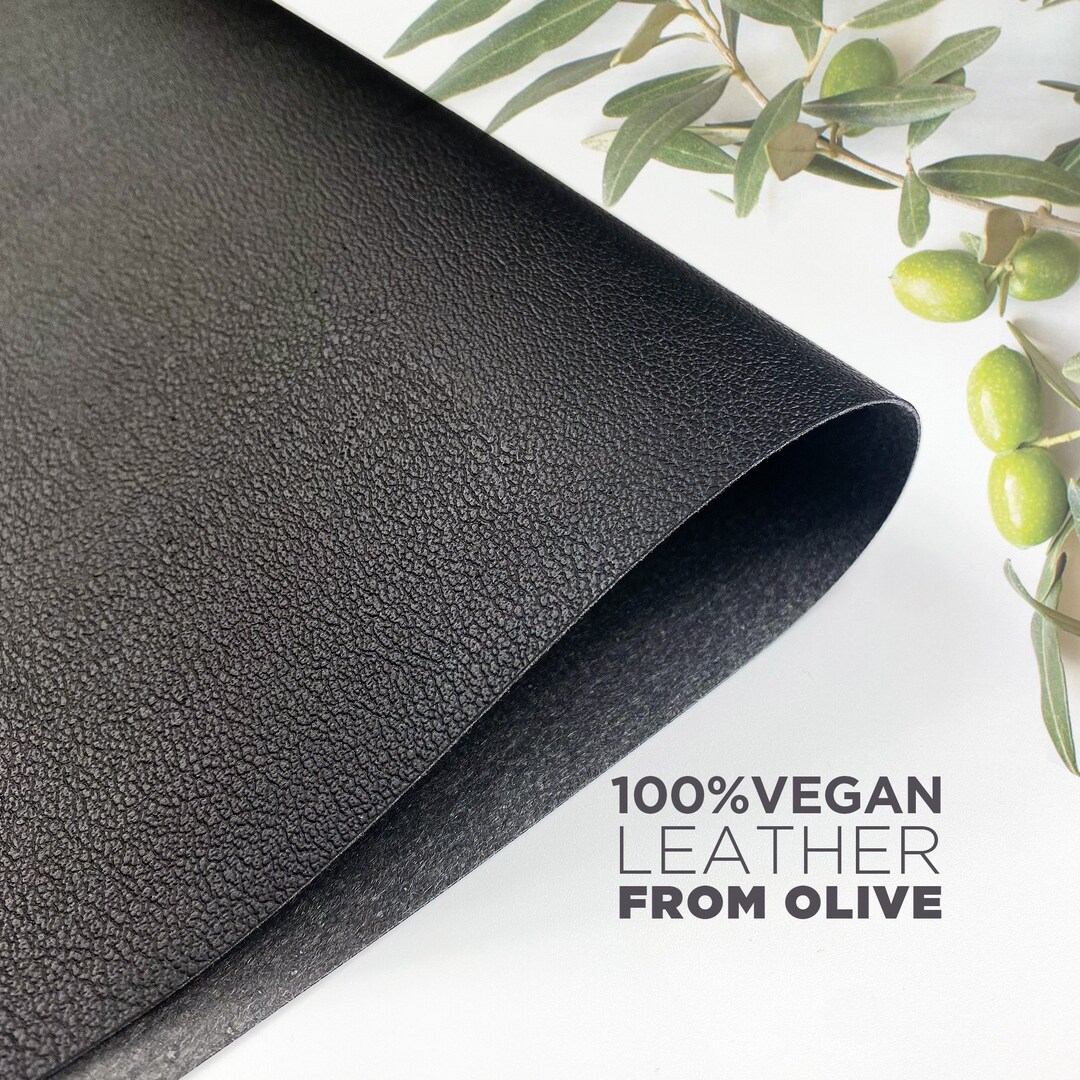
Illustrative image related to vegan leather fabric
-
Regulatory Compliance: Different countries may have varying regulations regarding materials and production processes. Buyers should ensure that suppliers comply with both local and international regulations relevant to their market.
-
Cultural Differences in Quality Standards: Understand that perceptions of quality may vary across regions. What is deemed acceptable in one market may not be the same in another. Clear communication about expectations is essential.
-
Supply Chain Transparency: Building relationships with suppliers who prioritize transparency can help buyers gain confidence in the quality of the products they are sourcing. This includes knowing the sourcing of raw materials and the production processes involved.
By understanding these manufacturing processes and quality assurance measures, B2B buyers can make informed decisions when sourcing vegan leather fabric, ensuring they partner with reliable suppliers who meet their quality standards.
Practical Sourcing Guide: A Step-by-Step Checklist for ‘vegan leather fabric’
In the rapidly evolving market for vegan leather fabric, B2B buyers must navigate a myriad of options and specifications to ensure they procure the right materials for their needs. This guide provides a practical checklist to streamline the sourcing process and enhance decision-making.
Step 1: Define Your Technical Specifications
Establishing clear technical specifications is critical before initiating the sourcing process. Consider the intended use of the vegan leather, such as apparel, upholstery, or accessories, as this will dictate the material’s required attributes—such as thickness, durability, and texture. Additionally, assess whether you need specific features like water resistance or breathability, as these factors can influence the performance of the final product.
Step 2: Research Material Options
With various materials available, it is essential to understand the types of vegan leather fabric on the market. Common options include polyurethane (PU), polyvinyl chloride (PVC), and plant-based alternatives like mushroom leather or cactus leather. Evaluate the sustainability and environmental impact of each option, as this is increasingly important to consumers and may affect your brand’s reputation.
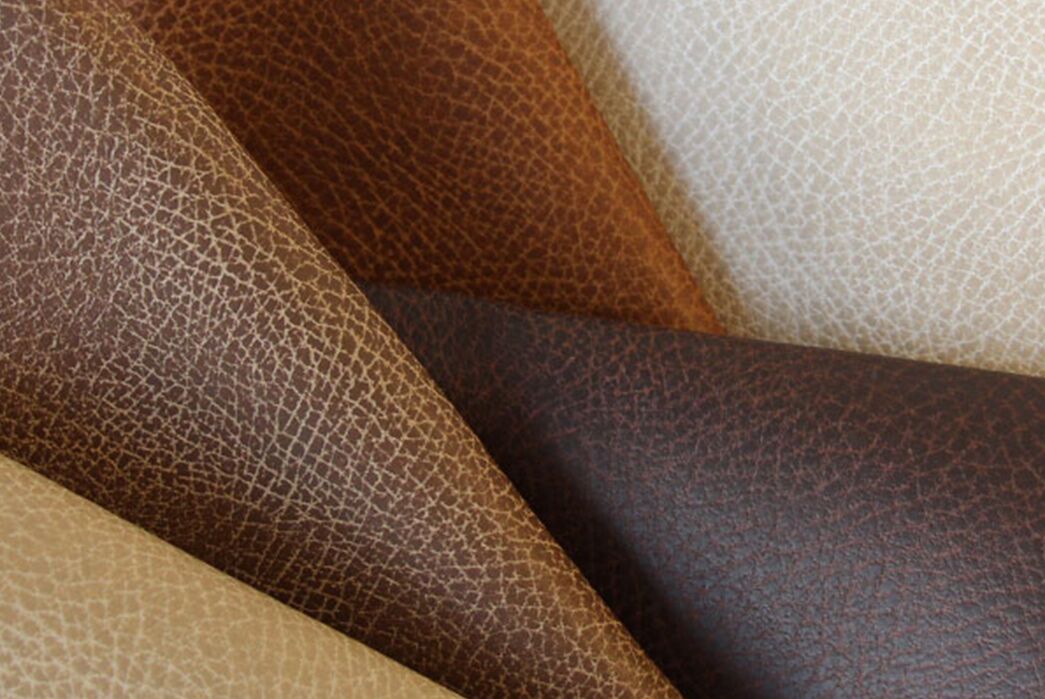
Illustrative image related to vegan leather fabric
Step 3: Evaluate Potential Suppliers
Before making a commitment, thoroughly vet potential suppliers to ensure they meet your requirements. Request detailed company profiles, production capabilities, and certifications that demonstrate compliance with industry standards. It’s advisable to ask for references or case studies from clients in similar markets to gauge their reliability and product quality.
- Supplier Certifications to Look For:
- ISO certifications
- Sustainability certifications (e.g., Global Organic Textile Standard)
Step 4: Request Samples
Always request samples before finalizing your order. This allows you to assess the quality, feel, and appearance of the vegan leather fabric firsthand. Examine the samples for consistency in texture and color, and test for durability and performance characteristics relevant to your application.
Step 5: Negotiate Terms and Pricing
Once you have identified suitable suppliers and evaluated samples, it’s time to negotiate terms. Discuss pricing, minimum order quantities, and lead times, ensuring that they align with your budget and production schedule. Be transparent about your expectations and explore options for bulk discounts or long-term agreements that could benefit both parties.
Step 6: Verify Shipping and Logistics
Shipping logistics can significantly impact your supply chain. Confirm the supplier’s shipping policies, including costs, delivery times, and packaging standards. If sourcing internationally, consider potential customs duties and import regulations specific to your country or region to avoid unexpected delays.
Step 7: Establish Quality Control Procedures
Implementing quality control procedures is essential to maintain product standards. Define inspection criteria and establish processes for monitoring the quality of the vegan leather upon arrival. This may include visual inspections and performance tests to ensure that the materials meet your specifications consistently.
By following this checklist, B2B buyers can navigate the complexities of sourcing vegan leather fabric effectively, ensuring they make informed decisions that align with their business needs and sustainability goals.
Comprehensive Cost and Pricing Analysis for vegan leather fabric Sourcing
What are the Key Cost Components in Vegan Leather Fabric Sourcing?
When sourcing vegan leather fabric, understanding the cost structure is crucial for informed purchasing decisions. The primary cost components include:

Illustrative image related to vegan leather fabric
-
Materials: The choice of raw materials significantly influences the price of vegan leather. Options range from synthetic materials like PVC and polyurethane to plant-based alternatives such as cactus, hemp, or apple leather. Higher-quality and sustainable materials generally incur higher costs.
-
Labor: Labor costs vary based on the manufacturing location. Regions with lower labor costs, such as parts of South America and Asia, may offer competitive pricing. However, quality assurance and skilled craftsmanship can increase labor expenses.
-
Manufacturing Overhead: This includes costs associated with running the manufacturing facility, such as utilities, rent, and maintenance. Efficient production processes can help mitigate these costs.
-
Tooling: Custom tooling may be required for specific designs or finishes, adding to the initial setup costs. Buyers should factor in these costs when evaluating suppliers.
-
Quality Control (QC): Investing in quality control processes ensures that the final product meets specifications and industry standards. This may involve additional costs but can prevent costly returns and disputes.
-
Logistics: Transportation and shipping costs are significant, especially for international buyers. Factors such as distance, shipping methods, and local tariffs can influence overall logistics expenses.
-
Margin: Supplier margins will vary depending on their operational costs and market positioning. It’s essential to understand what margin is built into the quoted prices to gauge overall value.
How Do Price Influencers Affect Vegan Leather Fabric Costs?
Several factors can influence the pricing of vegan leather fabric, particularly for international B2B buyers:
-
Volume/MOQ (Minimum Order Quantity): Larger orders often attract bulk pricing discounts. It’s beneficial for buyers to negotiate MOQ to optimize costs.
-
Specifications and Customization: Custom designs or specific material requirements may increase costs. Buyers should clearly communicate their specifications to avoid unexpected charges.
-
Material Quality and Certifications: The presence of certifications (e.g., sustainability certifications) can elevate the cost. High-quality materials that are eco-friendly or cruelty-free typically command a premium price.
-
Supplier Factors: The reputation and reliability of suppliers can impact pricing. Established suppliers may offer better quality but at a higher price point. Conducting thorough due diligence is essential.
-
Incoterms: Understanding shipping terms is critical for international transactions. Different Incoterms (e.g., FOB, CIF) can shift the cost burden and risk, affecting the overall price.
What Buyer Tips Can Enhance Cost-Efficiency in Vegan Leather Sourcing?
To maximize value in vegan leather sourcing, international buyers should consider the following strategies:
-
Negotiation: Engage suppliers in discussions about pricing, especially for larger orders. Flexibility in payment terms or delivery schedules can also lead to cost savings.
-
Total Cost of Ownership (TCO): Evaluate the complete cost of sourcing, including logistics, duties, and potential wastage. This holistic view helps in making more informed purchasing decisions.
-
Pricing Nuances for International Buyers: Be aware of currency fluctuations and economic factors in the supplier’s country that may affect pricing. Establishing long-term relationships can also lead to more favorable terms.
-
Market Research: Understand regional trends and market pricing for vegan leather. This knowledge can empower buyers during negotiations and help in identifying competitive suppliers.
Conclusion
Sourcing vegan leather fabric requires a comprehensive understanding of cost components and price influencers. By strategically approaching negotiations and evaluating total costs, international B2B buyers can enhance their sourcing efficiency and profitability. As the market continues to evolve, staying informed about trends and supplier dynamics will be key to successful procurement.

Illustrative image related to vegan leather fabric
Disclaimer: Prices are indicative and can vary based on market conditions, supplier negotiations, and specific order requirements.
Alternatives Analysis: Comparing vegan leather fabric With Other Solutions
Introduction to Alternative Solutions for Vegan Leather Fabric
As sustainability and ethical sourcing become increasingly important in the global market, vegan leather fabric has emerged as a popular alternative to traditional leather. However, various other materials and technologies also aim to provide similar benefits. This analysis will compare vegan leather fabric with two viable alternatives: cork fabric and polyurethane (PU) leather, highlighting their respective advantages and drawbacks.
Comparison Table
| Comparison Aspect | Vegan Leather Fabric | Cork Fabric | Polyurethane (PU) Leather |
|---|---|---|---|
| Performance | Durable, water-resistant | Lightweight, flexible | Highly durable, water-resistant |
| Cost | Moderate ($20-$80/yard) | Moderate ($25-$60/yard) | Low to moderate ($10-$30/yard) |
| Ease of Implementation | Easy to sew and work with | Requires specialized tools | Easy to handle and process |
| Maintenance | Low; wipe clean | Low; wipe clean | Moderate; may require special care |
| Best Use Case | Fashion, upholstery | Eco-friendly products, bags | Fashion, accessories, upholstery |
Detailed Breakdown of Alternatives
What Are the Advantages and Disadvantages of Cork Fabric?
Cork fabric, derived from the bark of cork oak trees, is a sustainable alternative that offers unique characteristics. It is lightweight and flexible, making it suitable for various applications, including bags and eco-friendly fashion. Cork is naturally water-resistant and resistant to mold and mildew, which enhances its durability. However, the initial cost can be higher than traditional materials, and while it provides a unique aesthetic, it may not appeal to all consumers. Additionally, the process of harvesting cork can be labor-intensive, which may impact the final pricing.
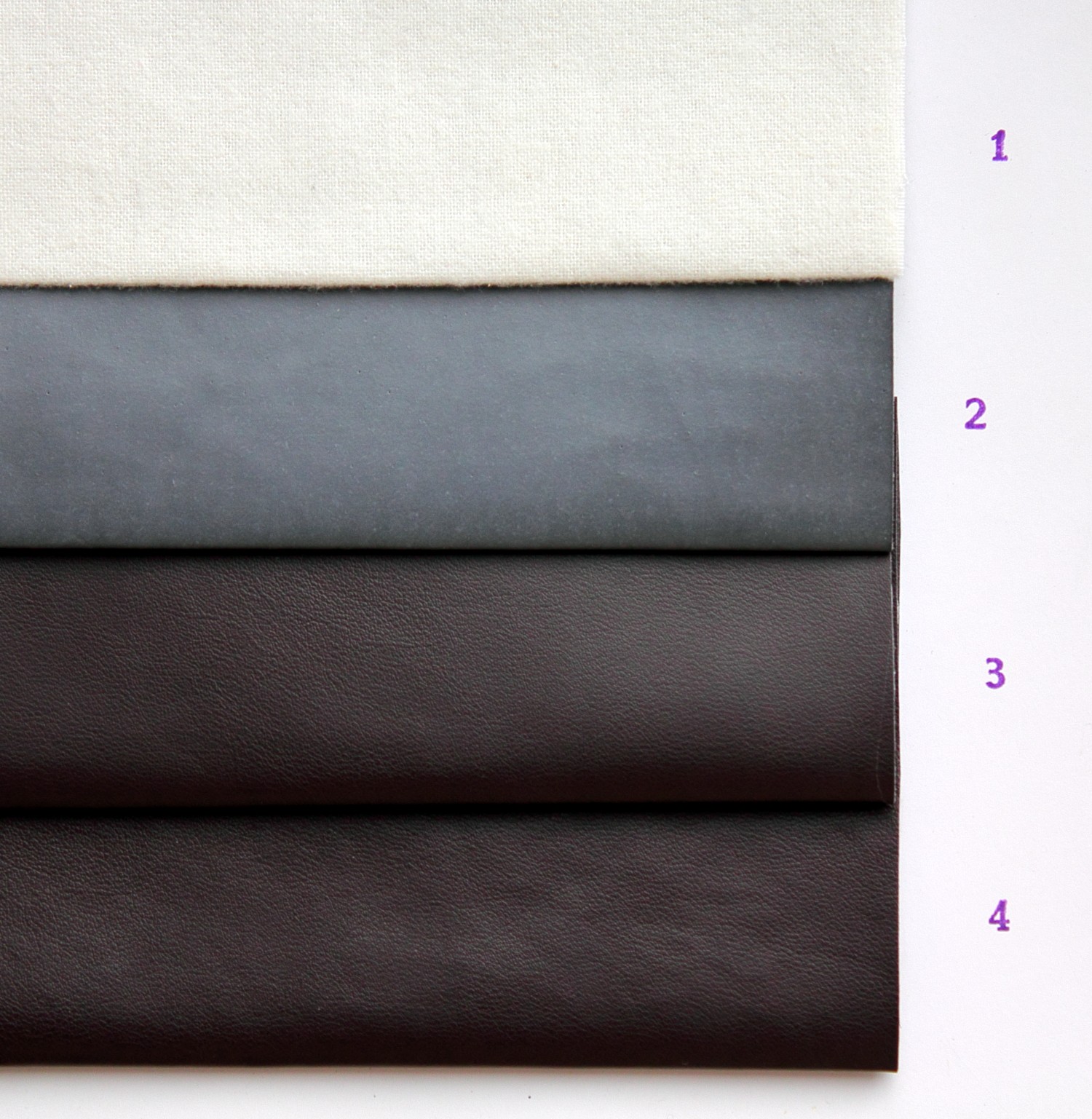
Illustrative image related to vegan leather fabric
How Does Polyurethane (PU) Leather Compare?
Polyurethane leather, commonly known as PU leather, is a synthetic alternative that mimics the look and feel of genuine leather. One of its primary advantages is cost-effectiveness, making it accessible for mass production in fashion and accessories. It is available in various textures and colors, offering versatility for designers. However, while PU leather is highly durable, it may not be as breathable as vegan leather fabric, which can affect comfort in certain applications. Additionally, PU leather’s synthetic nature raises concerns regarding environmental impact compared to more sustainable options like cork.
Conclusion: How Should B2B Buyers Choose the Right Solution?
When selecting the right material for your business needs, B2B buyers should carefully consider the specific applications and target markets. Vegan leather fabric offers a balance of durability and aesthetic appeal, making it ideal for high-end fashion and upholstery. Cork fabric shines in eco-conscious markets, providing unique design opportunities while promoting sustainability. On the other hand, PU leather can be a cost-effective option for bulk production, but it may lack the environmental benefits associated with natural materials. Ultimately, the choice should align with your brand values, customer preferences, and the intended use of the final product.
Essential Technical Properties and Trade Terminology for vegan leather fabric
What Are the Key Technical Properties of Vegan Leather Fabric for B2B Buyers?
When sourcing vegan leather fabric, understanding its technical properties is crucial for making informed purchasing decisions. Here are some essential specifications to consider:

Illustrative image related to vegan leather fabric
-
Material Composition
Vegan leather can be made from various materials, including polyurethane (PU), polyvinyl chloride (PVC), and plant-based fibers like pineapple leaves, apple peels, or cactus. The choice of material affects durability, appearance, and environmental impact. B2B buyers should assess the material composition to align with sustainability goals and consumer preferences. -
Thickness and Weight
The thickness of vegan leather is typically measured in millimeters or ounces per square yard. A standard thickness ranges from 0.5 mm to 1.5 mm. The weight, on the other hand, informs the fabric’s suitability for different applications, such as upholstery versus fashion. Knowing the right thickness and weight helps buyers select the appropriate fabric for their specific product needs. -
Durability and Abrasion Resistance
Durability is often assessed through testing methods like Martindale abrasion tests, which evaluate how well the fabric withstands wear and tear. A higher number indicates better durability. For B2B buyers, this property is vital for products that require long-lasting materials, such as automotive interiors or outdoor gear. -
Water Resistance and Breathability
Water resistance is essential for applications like outdoor furniture or clothing, while breathability ensures comfort in apparel. Vegan leather can be treated to enhance these properties. Buyers should consider the intended use of the fabric to ensure it meets functional requirements, particularly in regions with varying climates. -
Colorfastness and UV Resistance
Colorfastness refers to the fabric’s ability to retain color when exposed to light and washing. UV resistance is important for products that will be outdoors or in sunlight. B2B buyers should verify these specifications to ensure that the vegan leather maintains its aesthetic appeal over time, reducing the need for replacements.
What Common Trade Terms Should B2B Buyers Know When Sourcing Vegan Leather?
Familiarity with industry jargon can facilitate smoother transactions and negotiations. Here are some common terms to understand:
-
OEM (Original Equipment Manufacturer)
This term refers to a company that produces parts or equipment that may be marketed by another manufacturer. In the context of vegan leather, OEMs often provide custom solutions tailored to specific buyer requirements, making it essential for B2B buyers to identify reliable partners. -
MOQ (Minimum Order Quantity)
MOQ indicates the smallest quantity of goods that a supplier is willing to sell. Understanding MOQs is critical for budgeting and inventory management, as it influences how much product a buyer must commit to purchasing upfront. -
RFQ (Request for Quotation)
An RFQ is a document sent to suppliers asking for pricing and terms on specific products or services. B2B buyers should utilize RFQs to obtain competitive pricing and detailed terms from multiple suppliers, allowing for better decision-making. -
Incoterms (International Commercial Terms)
These are standardized trade terms that define the responsibilities of buyers and sellers regarding shipping, insurance, and tariffs. Familiarity with Incoterms helps buyers understand the logistics of international transactions and clarify cost responsibilities. -
Lead Time
Lead time refers to the amount of time it takes from placing an order to receiving the goods. For B2B buyers, understanding lead times is essential for planning production schedules and managing customer expectations. -
Sustainability Certifications
Certifications, such as GOTS (Global Organic Textile Standard) or OEKO-TEX, verify the sustainability claims of vegan leather products. B2B buyers should look for these certifications to ensure they are sourcing ethically produced materials that align with their brand values.
By grasping these essential technical properties and trade terms, B2B buyers can navigate the vegan leather market more effectively, making choices that enhance their product offerings and meet consumer demands.
Navigating Market Dynamics and Sourcing Trends in the vegan leather fabric Sector
What Are the Key Market Dynamics and Trends in Vegan Leather Fabric?
The global vegan leather fabric market is experiencing robust growth, driven by rising consumer awareness regarding animal welfare and environmental sustainability. As the demand for cruelty-free alternatives increases, international B2B buyers, particularly from Africa, South America, the Middle East, and Europe, are presented with unique opportunities. Key trends include the use of innovative materials such as pineapple leather, mushroom leather, and cactus-based textiles, which are gaining traction due to their sustainable properties. Additionally, advancements in manufacturing technologies, such as digital printing and 3D knitting, are enabling the creation of customized solutions tailored to specific market needs.
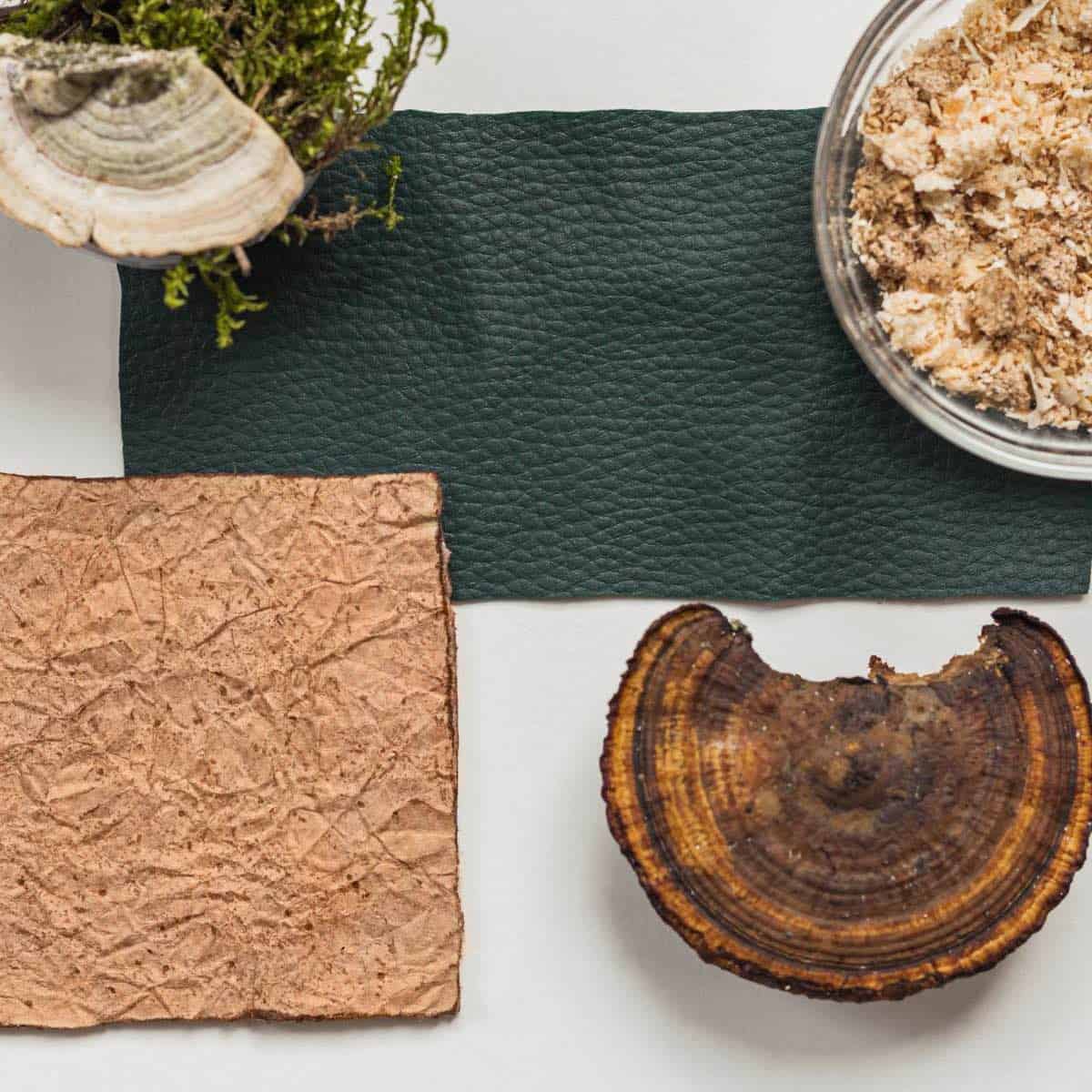
Illustrative image related to vegan leather fabric
Emerging B2B tech trends also include the integration of blockchain for supply chain transparency, allowing buyers to verify the ethical sourcing of materials. As transparency becomes a crucial factor for consumers, B2B buyers must align with suppliers who embrace these technologies. Furthermore, with the shift towards e-commerce, international buyers are increasingly leveraging online platforms for sourcing, enabling them to access a wider range of products and suppliers, ultimately leading to more competitive pricing.
How Can Sustainability and Ethical Sourcing Impact B2B Relationships in Vegan Leather Fabric?
Sustainability and ethical sourcing are paramount in the vegan leather fabric sector. The environmental impact of traditional leather production is significant, leading to deforestation, water pollution, and high carbon emissions. In contrast, vegan leather options often utilize recycled materials or plant-based resources, offering a more eco-friendly alternative. B2B buyers are encouraged to seek suppliers who prioritize sustainability, as this not only aligns with consumer expectations but also helps mitigate environmental risks associated with supply chains.
In this context, certifications such as Global Organic Textile Standard (GOTS) or OEKO-TEX can serve as valuable indicators of a supplier’s commitment to sustainability. These certifications ensure that the materials used in vegan leather fabrics are free from harmful chemicals and are produced under fair labor conditions. By prioritizing suppliers with recognized ‘green’ certifications, B2B buyers can enhance their brand reputation and meet the growing demand for responsible sourcing in their markets.

Illustrative image related to vegan leather fabric
What Is the Historical Evolution of Vegan Leather Fabric in the B2B Sector?
The evolution of vegan leather fabric dates back to the early 20th century when synthetic materials like PVC (polyvinyl chloride) were first introduced as alternatives to animal leather. Over the decades, advancements in technology have led to the development of more sophisticated materials, such as polyurethane (PU) and bio-based alternatives, which mimic the look and feel of genuine leather more effectively. The early 2000s saw a significant shift in consumer preferences, driven by increased awareness of animal rights and environmental issues, prompting manufacturers to innovate further.
Today, the vegan leather market is characterized by a diverse range of materials that not only provide aesthetic appeal but also focus on sustainability. This evolution reflects a broader cultural shift towards ethical consumption, influencing B2B purchasing decisions across various industries, including fashion, automotive, and home decor. As the market continues to grow, understanding this history can help international buyers appreciate the nuances of sourcing vegan leather fabrics and the importance of aligning with forward-thinking suppliers.
Frequently Asked Questions (FAQs) for B2B Buyers of vegan leather fabric
-
1. How can I ensure the quality of vegan leather fabric before purchasing?
To ensure the quality of vegan leather fabric, request samples from potential suppliers. Evaluate the texture, durability, and overall feel to ensure it meets your product specifications. Additionally, inquire about the manufacturing process and materials used, as this can significantly impact quality. Look for certifications or compliance with international standards, which can provide further assurance of the product’s quality. Establishing a clear quality assurance process with your supplier, including inspection protocols, can also help maintain standards throughout your order. -
2. What are the typical minimum order quantities (MOQs) for vegan leather fabric?
Minimum order quantities for vegan leather fabric can vary widely among suppliers, often ranging from 50 to 500 yards, depending on the type and customization options. When negotiating with suppliers, clarify if they can accommodate smaller orders, especially if you are a new buyer or testing a new product line. Many manufacturers may offer flexibility on MOQs for first-time orders or repeat customers. It’s advisable to establish a relationship with your supplier to negotiate better terms as your business grows. -
3. What customization options are available for vegan leather fabrics?
Customization options for vegan leather fabrics typically include colors, textures, and finishes. Some suppliers may also offer bespoke designs or printed patterns to suit your branding needs. When sourcing, ask about the minimums required for custom orders, as they may differ from standard offerings. Additionally, inquire about the lead times for customization, as this can impact your production schedule. Collaborating closely with your supplier during the design phase can ensure that the final product aligns with your vision. -
4. What payment terms should I expect when sourcing vegan leather fabric internationally?
Payment terms for international orders can vary based on the supplier’s policies and the buyer’s relationship with them. Common terms include a deposit upfront (often 30% to 50%) with the balance due before shipment. Some suppliers may offer credit terms for established buyers. It’s essential to clarify these terms during negotiations to avoid any surprises. Additionally, consider using secure payment methods, such as letters of credit or escrow services, to protect both parties in the transaction. -
5. How do I vet potential suppliers of vegan leather fabric?
Vetting suppliers involves thorough research and assessment. Start by checking their reputation through online reviews and industry references. Request information on their production capabilities, quality control measures, and certifications related to sustainability and ethical practices. Conducting factory visits, if possible, can provide firsthand insight into their operations. Establishing a clear communication channel to discuss expectations and concerns will also help in building a trustworthy relationship. -
6. What logistics considerations should I be aware of when importing vegan leather fabric?
When importing vegan leather fabric, consider shipping methods, costs, and delivery timelines. Understand the customs regulations in your country, including any tariffs or duties that may apply. Partnering with a logistics provider experienced in textile imports can facilitate smoother transactions. Additionally, ensure that your supplier is equipped to handle shipping logistics, including packaging and labeling requirements, to avoid delays at customs. -
7. Are there sustainable options available in vegan leather fabrics?
Yes, many suppliers offer sustainable vegan leather options made from materials like recycled plastics, cork, or plant-based sources such as pineapple or apple peels. When sourcing, inquire about the environmental impact of the materials used and the manufacturing process. Certifications like Global Organic Textile Standard (GOTS) or OEKO-TEX can indicate a commitment to sustainability. Opting for eco-friendly materials can enhance your brand’s reputation and appeal to environmentally conscious consumers. -
8. What should I know about the durability and maintenance of vegan leather fabrics?
Vegan leather fabrics generally offer good durability, though this can vary based on the specific material and finish. Most vegan leathers are resistant to water and stains, making them easier to clean than traditional leather. However, it’s important to follow the manufacturer’s care instructions to maintain the fabric’s appearance and longevity. Regular cleaning with a damp cloth and avoiding harsh chemicals can help preserve the quality over time. Consider discussing maintenance guidelines with your supplier to provide your customers with accurate care information.
Top 6 Vegan Leather Fabric Manufacturers & Suppliers List
1. Sallie Tomato – Faux Leather Collection
Domain: sallietomato.com
Registered: 2015 (10 years)
Introduction: Faux Leather collection by Sallie Tomato includes 66 products, primarily faux leather (65) and vinyl (1). Available colors include Beige (5), Black (10), Blue (6), Brown (10), Green (6), Grey (6), Navy (4), Orange (1), Pink (4), Purple (2), Red (6), Teal (1), White (2), Yellow (2). Textures offered are Alligator (4), Basket Weave (6), Crocodile (4), Legacy (15), Limited Edition (6), Lite (4), Ostr…
2. Reddit – Vegan Leathers and Alternatives
Domain: reddit.com
Registered: 2005 (20 years)
Introduction: High quality vegan leathers mentioned include Apple leather and cactus leather. Kraft-Tex is suggested as a durable alternative made from wood and cork that feels like leather. Waxed canvas is recommended for its longevity and aesthetic appeal. Upholstery shops may have vinyls that withstand extreme temperatures and wear, which could be suitable for crafting.
3. Fabric Wholesale Direct – Faux Leather Fabric
Domain: fabricwholesaledirect.com
Registered: 2014 (11 years)
Introduction: This company, Fabric Wholesale Direct – Faux Leather Fabric, is a notable entity in the market. For specific product details, it is recommended to visit their website directly.
4. Mood Fabrics – Faux Leather Fabric
Domain: moodfabrics.com
Registered: 2001 (24 years)
Introduction: Faux Leather Fabric by the Yard | Ethical Alternative
5. Alternative Leathers – Desserto® Cactus Leather
Domain: alternativeleathers.com
Registered: 2022 (3 years)
Introduction: {“products”:[{“name”:”Desserto® Cactus Leather”,”price”:”From $17.00″,”description”:”Unique and environmentally friendly material developed in Mexico, used by brands like Fossil and Adidas.”},{“name”:”Piñatex® Original Pineapple Leather”,”price”:”From $24.00″,”description”:”Sustainable alternative developed in the 1990s, used by trusted brands worldwide.”},{“name”:”Vegea® Grape Leather”,”price”:”F…
6. Alonso Mercader – High-Quality Faux Leather Fabric
Domain: alonsomercader.com
Registered: 1998 (27 years)
Introduction: Faux leather fabric by the yard, high quality, customizable for various projects. Suitable for contract upholstery, automotive, healthcare, nautical, and more. Available in PVC and polyurethane materials. Features include fire retardant, waterproof, indoor/outdoor use, and anti-stain treatments. Color options include black, white, beige, and various bright colors. Immediate availability in stock, …
Strategic Sourcing Conclusion and Outlook for vegan leather fabric
How Can Strategic Sourcing Enhance Your Supply Chain for Vegan Leather Fabric?
In the rapidly evolving landscape of vegan leather fabric, strategic sourcing emerges as a critical driver for success among international B2B buyers. By cultivating relationships with diverse suppliers, businesses can access a wider range of textures and materials, such as cactus and hemp-based options, which cater to varying consumer preferences and sustainability demands. This not only ensures competitive pricing but also aligns with the increasing global shift towards eco-friendly materials.
Understanding the nuances of sourcing vegan leather can significantly enhance product offerings. Buyers should prioritize suppliers who provide transparency regarding material sourcing and production practices. This fosters trust and positions businesses as leaders in sustainability, appealing to a conscientious consumer base.
As we look ahead, the demand for innovative, sustainable materials is set to grow, particularly in regions like Africa, South America, the Middle East, and Europe. Now is the time for B2B buyers to engage with suppliers that align with these trends. By integrating strategic sourcing into your procurement strategy, you can not only enhance your product portfolio but also contribute positively to the environment. Take the next step in your sourcing journey today—explore new partnerships and invest in the future of vegan leather fabric.
Important Disclaimer & Terms of Use
⚠️ Important Disclaimer
The information provided in this guide, including content regarding manufacturers, technical specifications, and market analysis, is for informational and educational purposes only. It does not constitute professional procurement advice, financial advice, or legal advice.
While we have made every effort to ensure the accuracy and timeliness of the information, we are not responsible for any errors, omissions, or outdated information. Market conditions, company details, and technical standards are subject to change.
B2B buyers must conduct their own independent and thorough due diligence before making any purchasing decisions. This includes contacting suppliers directly, verifying certifications, requesting samples, and seeking professional consultation. The risk of relying on any information in this guide is borne solely by the reader.


